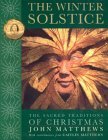|
Northern Yule - Winter Solstice -
|
At the dawn of civilization people in the Northern Hemisphere celebrated the time of the Winter Solstice. There was a good reason to do this.
They lived in agrarian societies, and the annual return of the sun provided the promise that planting would soon begin again, that life would go on.
Their societies honored the pagan gods - this was before Christianity had arrived - that they relied on for their crops and general welfare.
At this time of the year the work was pretty much done - winter had arrived with cold and snow. The harvest was in; livestock, which had fattened in the fields of summer, but could not be fed through the winter, had been slaughtered. Fresh meat had to be eaten quickly before it spoiled (or cured for later, less palatable consumption). There was plenty of other food and newly brewed drink.
Northern Yule
It was a time for celebration. Warfare was suspended, businesses were closed, homes and places of worship were decorated with greenery and light. On reflection, how similar is that to today?

Northern Yule
Those who yearn for spiritual meaning but aren't strongly affiliated with a specific religion sometimes feel left out of winter holidays.
Yule is like a hot toddy for these chilled and isolated souls. From mistletoe to gift exchanging, Yule explores and exalts the pagan and regional roots to many of our contemporary rituals and celebrations.
For example, lights were historically used to decorate winter homes in order to "frighten negative entities and urge the sun to shine," according to author Dorothy Morrison.
Many people believe that Santa's reindeer "represent the stags that drew the chariot of the Norse gift-giving goddess, Freya."
Beyond all the fascinating trivia, this is also a book that offers fresh approaches to old traditions, such as having a cleaning ritual that ceremoniously sweeps out the old and makes room for the new season or conducting a reverent "tree blessing" ceremony.
Morrison also suggests numerous homemade crafts and gift ideas (many are suitable for children), inviting seasonal recipes (such as Yuletide Ambrosia and Dragon's Layer Cake), and a December calendar that lists traditions and rituals for every day of the month.
Northern Yule
The festivities were marked by generalized goodwill as well as what had to be described as barbaric hedonism.
When early Christianity arrived, it struggled to become established. Its leaders understood the powerful hold the midwinter festival held on ordinary people. December 25 was celebrated in honor of Mithra, the Sun God. This cult, originated in Persia, had much in common with Christianity. Its beliefs included baptism, a doctrine of an Intercessor and Redeemer, a future life, and judgment to come.
Mithra had one major disadvantage, it held no place for women. Christianity held that women had souls and are equal to men.
In the middle of the fourth century, the Church decreed that henceforth the 25th of December would be recognized as the Day of Christ's Nativity. The Church hoped to draw the pagans from worship of the Sun God to worship of the Son of God.
It took a long time before the missionaries arrived in Scandinavia, but they did arrive.
While the pagans were willing to embrace Christianity, they had no intention of giving up their midwinter festivals. So, what came to be known as Christmas developed a split personality, religious and secular, sacred and profane.
This dual nature of Christmas observance is particularly true in Scandinavia. The dual nature of observance, pious and pagan, continued through the centuries.
From the middle ages until the reformation, the royal courts of Europe set the Christmas pace. Long church services were offset by the most elaborate festivities; plays and masques were performed.
Then came the reaction, in 1647, under Oliver Cromwell (in England), an act of Parliament forbade the observance of Christmas. And in North America, in 1659, under the government of the Puritans, it became illegal to celebrate Christmas. Christmas was stricken from the church calendar.
No such extremes were found in Scandinavia, but there was still a certain reluctance to accept the celebration of Christmas until the end of the eighteenth century.
Up until that time there was precious little that resembled the Christmas we know today - no family togetherness, no Christmas trees, no Christmas cards, no Christmas shopping, not much in the way of Christmas presents, and of course no Santa Claus.
All that was soon to change.
The date of New Year's Day has varied among different nations. Among the Egyptians, Chinese, Jews, and Romans it has been observed on dates varying from March first to December twenty-fifth.
It was as late as the Sixteenth Century before the date of January first was universally accepted as the New Year by the Romans.
Nations retaining the Gregorian calendar, such as Russia and Greece, observe it thirteen days later than those who reckon time by the Julian calendar.
Northern Yule
Among northern nations the love of fire and light originated the custom of kindling bonfires to burn out the old year and destroy all evil connected with its past.
Light has long been an expression of joy and gladness among all branches of the Aryan race.
The Greek and Latin Churches still term Christmas the "Feast of Lights," and make it a period of brilliancy in Church and home.
The Protestant covers the Christmas tree with lighted candles and builds a glowing fire on the hearth.
The innate love of light and warmth--the inheritance from the sun-worshipers of ages past--is always dominant in humanity at Yule-tide festivals - especially in Scandinavia.
Northern Yule Christmas Graphics


